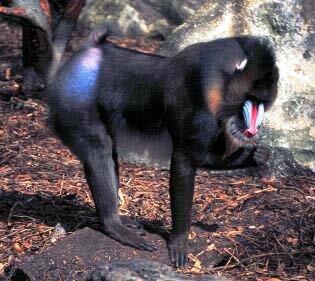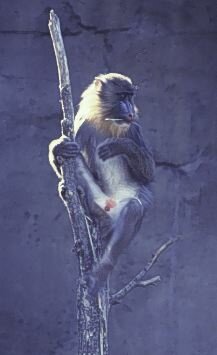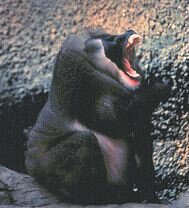DRILL and MANDRILL FACTS

| Family:Cercopithecidae |
Subfamily:Cercopithecinae |
| Genus:Mandrillus |
Species:two |
|
-
These species were included in the genus Papio(the baboon genus) until 1989. They have been discovered to be genetically distinct from baboons, and more akin to mangabeys. They do share many features with baboons, including, most notably, size. As with most primates, their taxonomy is under dispute. There are two subspecies of drill.
Appearance:
Drills are dark brown with a black face, white tufted beard and scarlet lower lip. They have a long muzzle with lateral ridges. Their hindquarters is naked and varies in color, which range from bright red, blue, and light purple to lilac and pink. Inner thighs are red. Males are larger and more colorful than females. Their skulls show a marked sexual dimorphism. Males average 28 inches in length and weigh around 37.5lbs. Females are normally 26 inches, 22 pounds.
Adult mandrill males are larger and more colorful than females. Their long snouts are red and blue and they have yellow-orange beards. They also have colorful rumps, which are thought to aid drills and mandrills in leading their groups through dense forests. These may also provide social and sexual signals. Males are about 40 in. long and weigh around 59 lbs., while females average 22 in. in length, 25 lbs. Adult brain weight is 5.6oz. Mandrills are the largest of all monkeys. Both drills and mandrills have very short tails. Both have cheek pouches, which enable them to store food to eat later.
Range and Diet:
Both are found only in West Africa, the drill in Nigeria, Cameroon, and the island of Bioko; the mandrill in Cameroon, Equatorial Guinea, and Gabon. They are found only in a very small area. Both live in forests and have can have group home ranges ranges of up to 5000ha. Drills have never been seen outside of forests, while mandrills may sometimes venture onto the savanna.
Both are omnivorous, eating fruit, seeds, vegetation, and small animal prey. Mandrills have been known to raid crops and plantations. They will travel long distances (5-15km) and feed most of the day. It has been suggested that mandrills live in a comparatively food-poor zone, the lower levels of the forest which are the least productive part, which accounts for their long daily travels. Their travels are similar to hamadryas baboons, which inhabit desert regions.
 Behavior and Social Structure:
Behavior and Social Structure:
Drills live in harem groups. One male can can as many as 20 females in his group. During the dry season several groups may come together to form one large group. As many as 200 individuals together have been observed. Males will emigrate and also can remain solitary. Mandrills normally form large multimale-multifemale groups with a distinct hierarchy. However, harem groups are not unheard of, as mandrill competition can be fierce. Dominant male mandrills are more colorful than lower ranked males. Group size can vary from 2 to over 200 individuals.
Both drills and mandrills are diurnal quadrupeds and can be arboreal or terrestrial. Adult males tend to be more terrestrial than females than females and juveniles, perhaps because of their larger size. Male drills forage at the rear of the group and herd the group away from danger. Mandrills will sleep in trees, in a different location each night.
Drills rely on visual and vocal communication, while mandrills also use scent marking. They are one of the few Old World monkeys to have cutaneous glands. Alpha males scent mark the most frequently. Drills have a series of deep grunts used for close contact communication, to get their group together, and to begin movement. Their loud, high-pitched "crowing call" is used contact subgroups that have separated for foraging. Juveniles alarm bark more than the others. Male mandrills have a 2-phase grunt or roar to round up their group. Drills have a "threat jerk," which consists of abruptly thrusting their heads forward, retracting eyelids, puckering lips, and raising the medial crest on their heads. Mandrills will "head bob" as a threat; and, like baboons, will yawn to display tension and warning. They greet each other (and others known and liked by them, like their favored zoo keepers) with a facial expression akin to a smile. This expression can be interpreted as a threat by some inexperienced observers who note the display of the mandrills' large teeth. Despite their fierce appearance, mandrills can be quite pleasant personalities and have also demonstrated impressive cognitive abilities.
 Reproduction and Lifespan:
Reproduction and Lifespan:
Drills reach sexual maturity at about 42mos. Females have an estrus cycle of 35 days and gestation length of around 174 days. Birth interval is generally 15 months. Lifespan is about 29 years.
Mandrills live longer, an average of 46 years. They are sexually mature a bit earlier also, at about 30 months. Female estrus cycle is 33 days, and they display a small swelling betwen their callosities. Gestation is 220 days with a birth interval of 17 months. Mandrills also have mating seasons which fall between July and October. This is dry season in Gabon. In captive studies higher ranking mandrills have greater access to estrus females and, according to DNA tests, fathered the most infants.
Conservation Status:
Both species have been classified as Endangered by the USESA. Both are hunted for meat. Drills' habit of "standing their ground" during an attack has made them preferred game in Nigeria, because several can be shot at one time. These are found in small, isolated patches of forest.
 Interesting Drill and Mandrill Facts:
Interesting Drill and Mandrill Facts:
Because their deep forest habitat makes them difficult research subjects, and because they are wary of humans, drills and mandrills have never been successfully studied in their native habitats.
Current Research with Drills and Mandrills:
(Note: The following are examples of recent research done with these primates, it is by no means an exhaustive list. This list will be periodically updated as more information becomes available. Also, though Mindy's Memory Primate Sanctuary DOES NOT support invasive medical research on primates, some articles of this type will be listed - both for information and as examples of the work that is currently being done with these animals.)
Anonymous.
About the endangered drill monkey. IPPL NEWS 25(1): 22, 1998.
Anonymous.
The Drill Rehab and Breeding Center. IPPL NEWS 25(1): 22, 1998.
Chang TR; Forthman DL; Maple TL
Comparison of confined mandrill (Mandrillus sphinx) behavior in traditional and "ecologically representative" exhibits. ZOO BIOLOGY 18(3): 163-176, 1999.
Cox, C R
Drills (Mandrillus leucophaeus): Research and conservation initiatives, 1986 - 1996. Pp. 151-175 in PRIMATE CONSERVATION: THE ROLE OF ZOOLOGICAL PARKS. J. Wallis, ed. Location?, Amer Soc of Primatol, 1997.
Joscelyn TE
Reconciliation and other post-conflict behaviour in captive drill and mona monkeys. MASTERS ABSTRACTS 37(1): 87, 1999. (To order: #AADMQ-31295. University Microfilms, Inc, Ann Arbor, MI 48106)
LaRue MD
MANDRILL MANDRILLUS SPHINX REGIONAL STUDBOOK, CANADA, UNITED STATES AND MEXICO - No. 9. Topeka, Topeka Zool Park, 1998, 115 pp.. (Data through 9/23/98)
LaRue, M D
MANDRILL MANDRILLUS SPHINX REGIONAL STUDBOOK, CANADA, UNITED STATES AND MEXICO. No. 8. Topeka, KS, Topeka Zool Park, 1997, 124 pp. (Data through 7/31/97)
Wickings, E J
Genetic self-management in a captive colony of mandrills (Mandrillus sphinx) as revealed by DNA minisatellite fingerprints. ELECTROPHORESIS 16(9): 1678-1683, 1995.
Drill and Mandrill Websites
(includes vocalizations)
References:
Rowe N (1996) The Pictorial Guide to the Living Primates. East Hampton: Pogonias Press
Sleeper B (1997) Primates. San Francisco: Chronicle Books
Stammbach, E (1987) Desert, Forest and Montane Baboons: Multilevel-Societies. In Primate Societies. Smuts, et al., eds. Chicago: University of Chicago Press. pp. 112-120.
